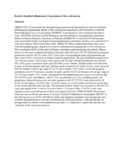| dc.contributor.author | Awange David O. | |
| dc.contributor.author | Wakoli Kavin A. | |
| dc.contributor.author | Onyango John F. | |
| dc.contributor.author | Chindia ML. | |
| dc.contributor.author | Dimba Elizabeth A. | |
| dc.contributor.author | Guthua Symon W. | |
| dc.date.accessioned | 2013-04-08T12:39:50Z | |
| dc.date.available | 2013-04-08T12:39:50Z | |
| dc.date.issued | 2009 | |
| dc.identifier.citation | East Afr Med J. 2009 Feb;86(2):79-82 | en |
| dc.identifier.uri | http://www.ncbi.nlm.nih.gov/pubmed/19894472 | |
| dc.identifier.uri | http://erepository.uonbi.ac.ke:8080/xmlui/handle/123456789/15544 | |
| dc.description.abstract | OBJECTIVE: To document the histopathological pattern and distribution of reactive localised inflammatory hyperplastic lesions of the oral mucosa diagnosed at the University of Nairobi Dental Hospital over a 14 year period.
DESIGN:
A retrospective, cross-sectional descriptive study.
SETTING:
Division of Oral Pathology and Oral Medicine, histopathology laboratory, School of Dental Sciences, University of Nairobi.
SUBJECTS:
A total of 3135 oral biopsies were accessioned in the oral diagnostic histopathological Laboratory registry over a period of 14 years from March 1991 to December 2005.
RESULTS:
Three hundred and thirty three cases were histopathologically diagnosed as reactive inflammatory hyperplasias of the oral mucosa. This constituted 10.6% of the total oral biopsy specimens analysed during this period. Fibrous epulis was the most common histological sub-type with 129 cases (38.7%) followed by pyogenic granuloma with 94 (28.3%) cases. Six (1.8%) cases were peripheral giant cell granuloma and three cases (0.9%) were those of denture irritation hyperplasia. The age distribution ranged from 2 to 78 years (mean = 30.5 years) with a peak at 20-29 years. Gender distribution showed that 107 (32%) cases occurred in males and 226 (68%) cases females. Similar trends were observed in most of the histological sub-types. Fibrous epulis occurred in 41 male (31.8%) cases and in 88 (68.2%) females with an age range of 2 to 78 years (mean = 30.5 years). As for the pyogenic granuloma, 26 (27.7%) lesions occurred in males and 68 (72.3%) in females with an age range of 2 to 75 years (mean = 30.1 years). Among all the histopathological sub-types it was shown that 223 (67.0%) cases were fibrous, 104 (31.2%) vascular and six (1.8%) peripheral giant cell granuloma. Gingival lesions were the most common with 257 (77.2%) cases followed by 28 (8.4%) in the tongue, 16 (4.8%) lips, 15 (4.5%) cheek, six (1.8%) palate and the rest on the floor of the mouth and other mucosal sites. The duration of these lesions was recorded in 182 (54.7%) cases and ranged from 1 week to 16 years (mean = 1.8 years). Only 15 (4.5%) cases were reported to have recurred and all of them were gingival lesions.
CONCLUSION:
The present study has shown that the prevalence of reactive localised inflammatory hyperplasia (RLIHs) of the oral mucosa was 10.6% with fibrous epulis and pyogenic granuloma having been the most common histopathological sub-types predominantly affecting females. Although RLIHs are distinguished on clinical or histopatholocal grounds, it is important to appreciate that they are variations of the same basic process | en |
| dc.language.iso | en | en |
| dc.title | Reactive localised inflammatory hyperplasia of the oral mucosa | en |
| dc.type | Article | en |
| local.publisher | Department of Oral Pathology and Oral Medicine, School of Dental Sciences, University of Nairobi, | en |


